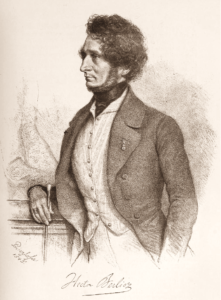On March 8, 9 and 10, the Houston Symphony presents a delectable all-French program featuring mezzo-soprano Susan Graham singing one of her signature pieces: Berlioz’ Les nuits d’été. In this post, discover how Berlioz’ turbulent personal life may have influenced this gorgeous, Romantic song cycle. Get tickets and more information here.

After years of stalking his celebrity crush, the great Shakespearean actress Harriet Smithson, Hector Berlioz vented his romantic frustrations in one of the most influential pieces of music in history: his Symphonie fantastique. The work made him famous, and he renewed his entreaties to Harriet. After threatening to commit suicide in front of her, she at last agreed to marry him.
Though nearly everyone they knew advised them against it, the unlikely couple was married on October 3, 1833. Despite the unusual circumstances of their courtship and straitened finances, the marriage succeeded for several years. But Harriet’s star waned as Hector’s rose, and she irrevocably slipped into the clutches of depression and alcoholism. Though Hector would continue to support and care for her until her death in 1854, by the early 1840s the marriage was effectively over.
Given its themes of love and loss, some have speculated that Berlioz processed the breakup of his marriage through the song cycle Les nuits d’été (Summer Nights). Completed by the summer of 1841, the cycle is based on poems by Théophile Gautier, an acquaintance who lived near Berlioz in Paris. Like Berlioz, Gauthier was forced to earn his bread and butter as a journalist in the philistine world of July Monarchy France, but he is remembered as a leading Romantic in French literature.
Berlioz originally composed Les nuits d’été for mezzo soprano or tenor voice and piano, but later orchestrated it. It seems he also intended the orchestrated version to be sung by other types of voices, including contralto or baritone for some of the songs. The cycle, however, is almost exclusively sung by mezzo-sopranos. This might seem odd, as the speaker of the poems is male (or at least is in love with a woman), but this could be explained by the operatic tradition of casting sopranos and mezzo-sopranos as boys or adolescent youths, the higher voice being an indicator of youthfulness. The range of the songs in their orchestral guise also fits that of a gifted mezzo, and perhaps most compellingly, they simply sound excellent when sung by a beautiful mezzo-soprano voice.
The opening “Villanelle” invites the beloved to wander through the forest in springtime and features a simple, charming melody above a chirping accompaniment; even in this happy song, however, shadows pass over the music, belying its innocent surface (text and translation available here):
https://www.youtube.com/watch?v=c3aX4Wfz59g
In “Le spectre de la rose” (“The Specter of the Rose”), the ghost of a rose remembers the night it spent pinned to a beautiful woman’s dress at a ball (text and translation available here). The rose does not regret its death, but instead proclaims that “all kings will envy it.” The song contains some of Berlioz’ most evocative and expressive effects.
In “Sur les lagunes” (“On the Lagoons”), a sailor grieves for a dead beloved, saying “How bitter my fate is! Ah! Without love to set out on the sea!” (text and translation available here). Subtitled “lament,” this mournful song fades away poetically on an unresolved half-cadence. In “Absence,” a vast distance separates the singer from the beloved (text and translation available here). In context, the distance could metaphorically refer to that between this life and the hereafter. The most chilling of the songs, “Au cimetière” (“In the Cemetery”), depicts a gothic scene in which the ghost of the beloved calls to the singer from beyond the grave (the apparition is evoked by ghostly violin and viola harmonics). In this song the singer at last breaks free from grief, resolving never to return to the cemetery (text and translation available here). In the final song, “L’île inconnue” (“The Unknown Isle”), the singer steers a fanciful ship over the open ocean, asking a new beloved “Where would you like to go?” (text and translation available here). She answers: “Take me to the faithful shore, where one loves forever.” “That shore is hardly known, my dear, in the land of love,” the singer responds. —Calvin Dotsey
We want to hear from you! Tell us what you think in the comments below.
Don’t miss Berlioz’ Les nuits d’été March 8, 9 and 10, 2019! Get tickets and more information at houstonsymphony.org



